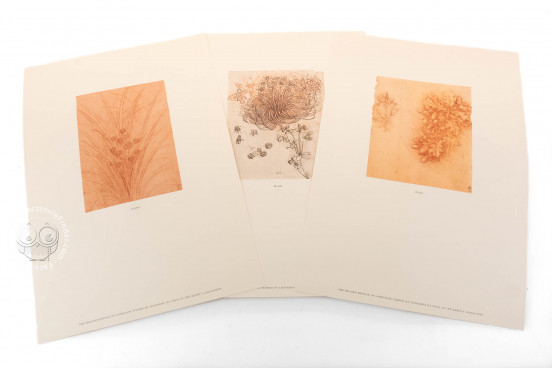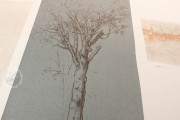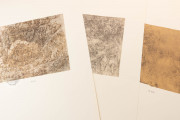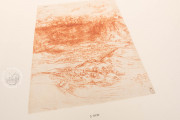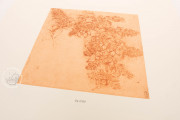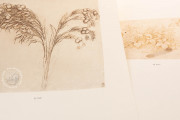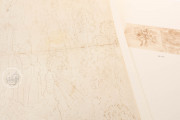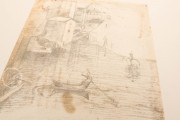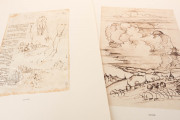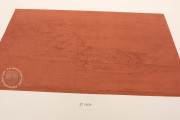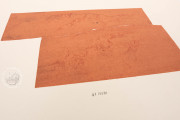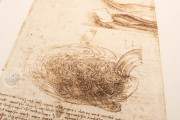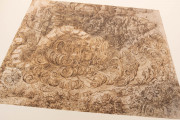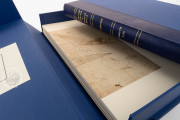Leonardo da Vinci's Landscapes and Plants and Water Studies is a collection of drawings, variously executed in ink, chalk, and silverpoint, bearing witness to Leonardo's passion surrounding the phenomena of nature. Flowers, plants and the movement of water are depicted with scientific precision: plants are shown in relation to the terrain where they grow, water is portrayed in all its headlong, destructive fury as part of an overall vision of atmospheric activity and turbulence, and mountains are studied from a geological viewpoint.
This collection includes the following groups of drawings:
I. The 'Theme Sheet', ca. 1489-90
II. Early Studies, ca. 1478 and ca. 1485
III. Narrative Landscapes, ca. 1495-1500 and later
IV. Black Chalk Mountains, ca. 1506-8 and later, ca. 1510-15
V. Leda Plant Studies, ca. 1506-8 and later, ca. 1513-14
VI. Studio Works, ca. 1505 and later
VII. Red on Red Drawings, 1511
VIII. Water Studies, ca. 1509 and later, ca. 1513
IX. Adda River Views, ca. 1513
X. Symbolic Landscapes and Deluges, ca. 1513-15 and later
During the fifteenth century in Florence, many painters, including Leonardo, became captivated by the allure of landscapes, flora, and trees. This fascination with nature's beauty was not entirely new, as late Gothic artists had previously explored similar themes.
Artistic Tradition and Lost Florals
Leonardo's contributions to this genre must be understood in the context of an evolving artistic tradition. Although earlier artists had likely created numerous floral drawings, few, if any, have survived. These drawings were often deemed insignificant, serving as mere means to an end. Nevertheless, there are references to Molti fiori ritratti di naturale (many flowers drawn from life) in an early list of Leonardo's works, though none of these specific flower studies remain.
Botanical Studies and Medieval Influence
In 1483, for the commission of the Virgin of the Rocks, Leonardo returned to extensive plant studies, indicating his ongoing interest in botany. He was also exposed to medieval herbals, which combined Christian symbolism, decorative patterns, and scientific observations. This blend of art and science deeply fascinated him. Leonardo even noted in 1493 that "Maestro Giuliano da Marliano has a beautiful herbal." He also possessed an herbal referred to as "erbolajo grande." It is apparent that he was passionate about acquiring knowledge in this field and intended to compile his own collection of plant drawings.
Scientific Approach to Natural Elements
As his scientific approach grew more pronounced, Leonardo began to consider the relationship between plants and their environments. His drawings of rock formations, often accompanied by plants and water, exude a unique sense of vitality. Leonardo's study of water, in particular, went beyond mere observation. He recognized the interconnectedness of natural elements and sought to depict them with scientific accuracy. His drawings of storms, cataclysms, and turbulent waters, marked by dramatic use of light and shade, are notable for their precision.
Sketches and Nature Studies
Some of Leonardo's landscape drawings were preparatory sketches for paintings, while others were pure nature studies. His sketches of riverbanks around Villa Melzi at Vaprio d'Adda showcase his exceptional skill and precision in rendering landscapes. These drawings, though small in scale, display the intricate details of nature and hint at Leonardo's desire to excel in every aspect of his art.
Rock Formations and the Deluge Series
Leonardo's black chalk drawings of rock formations, which are strongly connected to the background of the Louvre Virgin and St. Anne, exhibit boldness and power. These drawings paved the way for the Deluge series, a collection of his most enigmatic works. These drawings, marked by swirling waters, are a culmination of Leonardo's deep fascination with the movement of water, which he likened to the flow of blood and wavy hair.
Apocalyptic Visions
Notably, some of Leonardo's Deluge drawings hint at apocalyptic visions, featuring impossible natural phenomena that symbolize universal destruction. The interplay between scientific observation and symbolism characterizes the complexity of Leonardo's mind during his later years. This shift in focus led his contemporaries to view him less as a painter and more as a magician with profound insights into the mysteries of the universe. These drawings, rich in both artistic and scientific merit, serve as a testament to Leonardo da Vinci's enduring influence on art and science.
We have 1 facsimile edition of the manuscript "Landscapes and Plant and Water Studies by Leonardo da Vinci (Collection)": Drawings and Miscellaneous Papers of Leonardo da Vinci in the Collection of Her Majesty the Queen at Windsor Castle: Landscapes, Plants and Water Studies facsimile edition, published by Johnson Reprint, 1982
Request Info / Price
